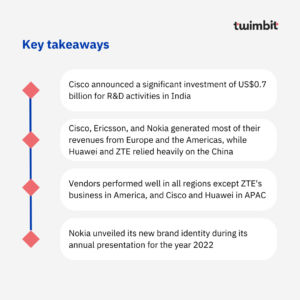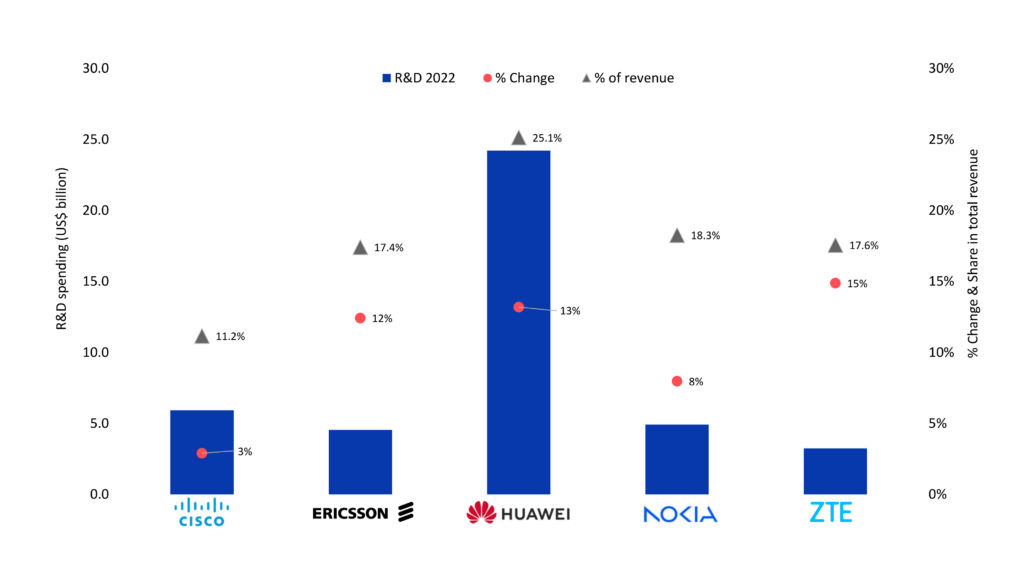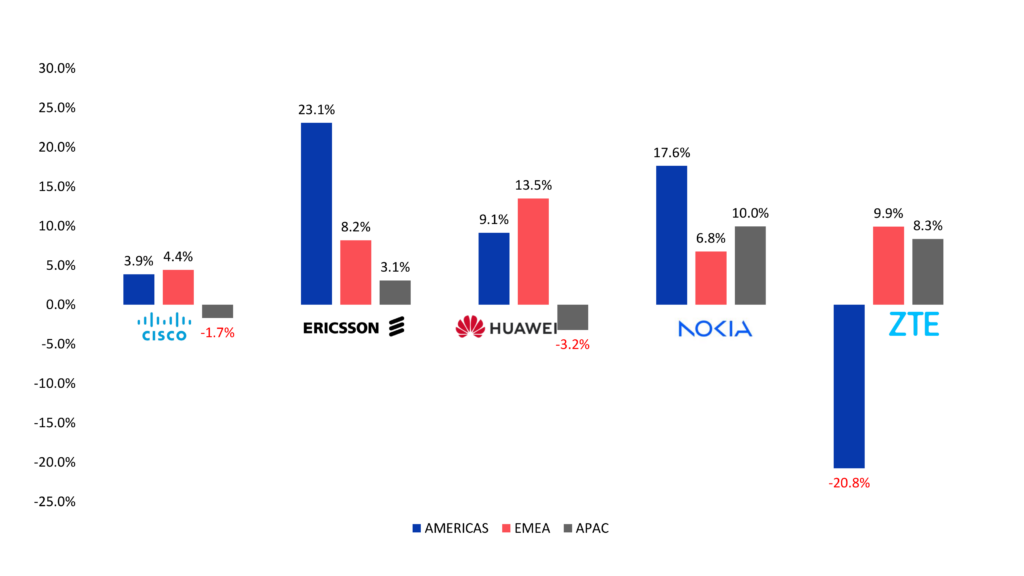Key Takeaways
- The vendors experienced positive revenue growth in 2022, with a combined growth of 8 percent (excluding consumer business for Huawei and ZTE), while their overall revenue inclusive of consumer business for Huawei and ZTE grew by 4.9 percent YoY.
- Enterprise business emerged as a new hotspot for vendors, with a robust growth of 20.1 percent YoY, driven by the demand for private networks.
- Huawei took the lead in R&D investment with an investment of 25 percent of total revenue. It has a total of 55.4 percent of its workforce dedicated to R&D.
- Cisco announced a significant investment of US$0.7 billion for R&D activities in India.
- Cisco, Ericsson, and Nokia generated most of their revenues from Europe and the Americas, while Huawei and ZTE relied heavily on the Chinese market.
- Regional performance was mixed, with vendors performing well in all regions except for ZTE’s business in America, and Cisco and Huawei in APAC.
- Nokia unveiled its new brand identity during its annual presentation for the year 2022. It is working on shifting the perception of Nokia from a mobile infrastructure vendor to a business technology solution provider.
This report provides a comprehensive review of the performance of the top five global telecom vendors – Cisco, Ericsson, Huawei, Nokia, and ZTE in 2022. The report focuses on providing insight into the benchmarking of their carrier and enterprise business. As a result, we have excluded the consumer business of ZTE and Huawei from this analysis. It covers:
- Financial Performance in 2022
- R&D investment
- Region-wise performance
- Major Achievements in 2022
Financial Performance in 2022
The vendors experienced positive revenue growth in 2022, with a combined growth of 8 percent (excluding consumer business for Huawei and ZTE), while their overall revenue inclusive of consumer business for Huawei and ZTE grew by 4.9 percent YoY. The vendors’ revenue growth in 2022 is as follows:
- Nokia and Ericsson saw a significant increase in their business, with growth rates of 12.2 percent and 13.9 percent respectively.
- Cisco experienced a moderate growth rate of 3.1 percent.
- Chinese vendors, Huawei and ZTE, also witnessed strong growth of 8.9 percent and 6.6 percent on like-to-like basis, excluding their consumer business while total revenue for ZTE and Huawei grew by 7.4 percent and 0.9 percent respectively on YoY basis.
Exhibit 1
Total revenue (in US$ billion) and its share by customer type
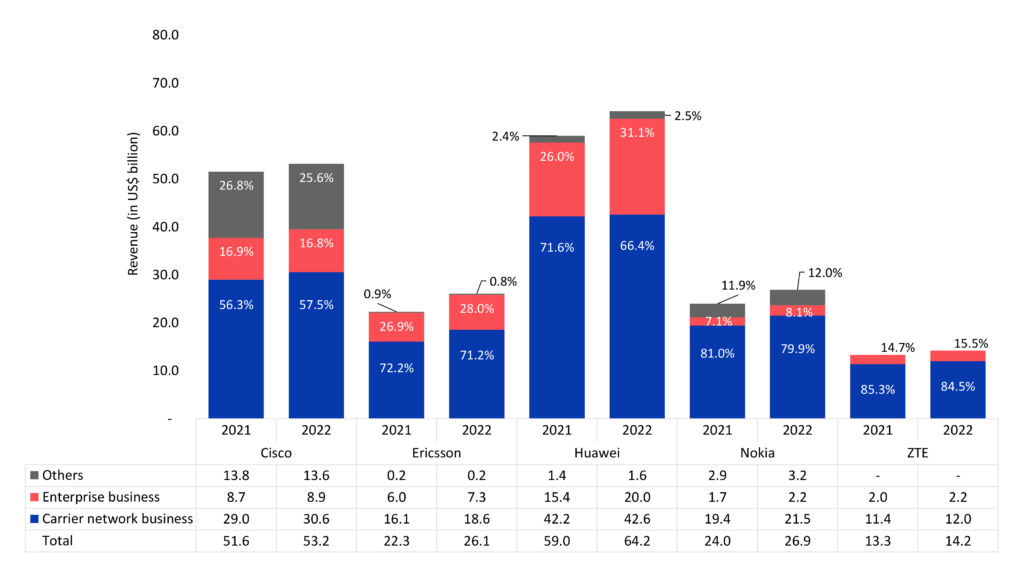
Note:
1. Consumer business revenue excluded for Huawei and ZTE
2. Cisco’s financial performance is from February 2022 to January 2023
Cisco and Nokia remain at the forefront of market share among these vendors, with Ericsson experiencing a 1 percent increase in market share as a result of its acquisition of Vonage in the latter half of 2022.
Exhibit 2
Revenue share by vendor
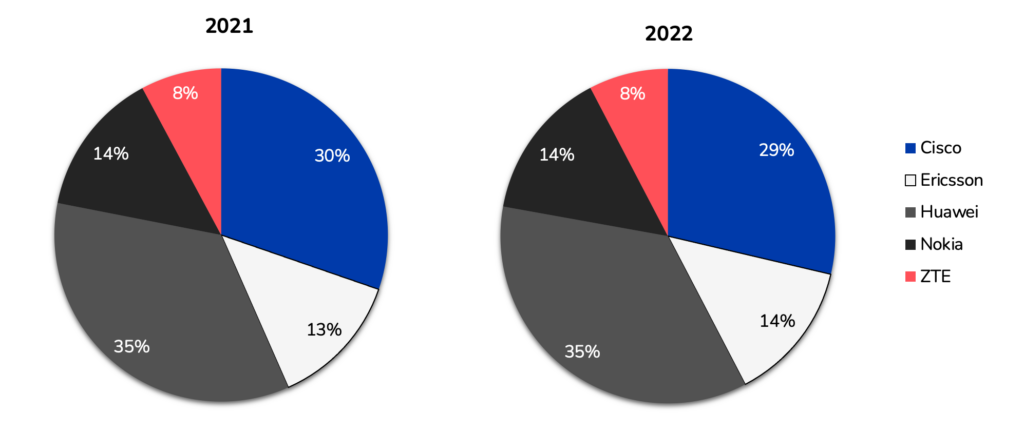
Note:
1. Consumer business revenue excluded for Huawei and ZTE
2. Cisco’s financial performance is from February 2022 to January 2023
Most vendors experienced strong double-digit growth in enterprise business fuelled by the growing demand for 5G-optimized networking and security solutions. Although Cisco did not achieve the same level of growth, the overall positive trend showcases the immense potential of the enterprise segment in the industry. In 2022, the enterprise businesses of vendors combined grew by an impressive 20.2 percent.
Exhibit 3
Revenue growth % by customer type

Note:
1. Consumer business revenue excluded for Huawei and ZTE
2. Cisco’s financial performance is from February 2022 to January 2023
Cisco
Cisco’s revenue growth was driven by strong performance of its largest business segment, carrier network business, which grew by 5.5 percent. Its enterprise revenue growth was lowest in its peer group at 2.4 percent compared with the industry average of more than 20 percent growth in the enterprise revenue.
Ericsson
Ericsson’s enterprise business achieved significant growth in 2022 with a remarkable increase of 21.5 percent on a like-to-like basis. Furthermore, including the financials of Vonage, Ericsson’s enterprise business surged by a staggering 146.6 percent on a YoY basis. The IPR licensing revenues also increased by 8.1 percent, mainly due to a new patent license agreement including 5G in Europe.
Huawei
Despite facing challenges due to the sanctions imposed on using the Android operating system in their smartphones, Huawei’s overall revenue increased by 0.9 percent YoY. This was largely attributed to the impressive growth of their enterprise business, which witnessed a 30 percent increase in revenue. This success can be attributed to the innovative 5G product offerings developed by Huawei. However, there was a revenue decline of 11.9 percent in their consumer business.
Nokia
Nokia experienced robust revenue growth, driven by the strong demand from the carrier network business. The enterprise revenue also surged by 27.4 percent due to the strong growth in private wireless, with more than 560 customers now on board. Customer engagement remained positive, with 307 new enterprise customers added in 2022.
ZTE
ZTE’s revenue growth remained strong in 2022, with positive results across all business segments. Its carrier networks business, which makes up 65.1 percent of total revenue, saw a YoY increase of 5.7 percent from fixed-line, core network, and server products. Meanwhile, ZTE’s enterprise business reported a YoY increase in revenue of 11.8 percent, largely driven by server products. The company’s consumer business, which accounts for 23 percent of total revenue, also showed impressive YoY growth of 9.9 percent, mainly attributed to increased sales of home information terminals and handset products.
R&D investment
R&D investment is an important metric for these telco vendors as it increases market participation and advances marketing abilities to ahead of its competition. R&D spending of all 5 vendors covered in this report grew by 11.1 percent in 2022 contributing 19.2 percent of their total revenue.
Exhibit 4
R&D spending by vendors
Cisco
Cisco witnessed a YoY increase of 2.9 percent in its research and development expenses, which reached US$ 5.9 billion. This growth was largely driven by the company’s strategic decision to boost its ICT R&D investment overseas, with India being a prominent area of focus. To this end, Cisco has announced an investment of US$ 1.1 billion in India over the next three years, out of which US$ 0.7 billion has been allocated for research and development activities, including staffing, development, and training. It is noteworthy that a significant proportion (93 percent) of Cisco’s Indian workforce is dedicated to the R&D department.
Ericsson
Ericsson witnessed a notable surge in its R&D expenses, up by 12.4 percent, primarily driven by its networks and enterprise segments. In particular, the Networks division saw a substantial increase in R&D expenses, which can be attributed to continued investments in Cloud RAN and Ericsson Silicon (ASICs). Additionally, the acquisition of Vonage also contributed to the increase in R&D expenses in expanding the Enterprise Wireless Solutions portfolio.
Huawei
Huawei invested 25.1 percent of its total revenue in R&D and had 55.4 percent of its workforce dedicated to R&D by the end of 2022. With 86 tech labs worldwide, Huawei is leading the 5.5G roadmap, advancing ICT infrastructure and AI. As a patent industry leader, hundreds of companies use Huawei’s patented technologies through patent pools and agreements. In 2022, 29 companies from various regions and countries including China, the US, Europe, Japan, and South Korea signed new licensing agreements with Huawei to utilize the company’s patented technologies, further cementing its leadership in the industry.
Nokia
Nokia’s strategic plan to establish itself as a leader in B2B technology innovation and achieve sustainable, profitable growth has involved significant investments in R&D. The company has allocated 18.3 percent of its revenue towards R&D to become a B2B technology innovation leader. As we move towards 5G-Advanced and 6G, Nokia plans to increase its R&D investment to keep pace with the demands of fully immersive technologies. In the coming years, Nokia plans to further enhance its R&D investment to unleash the full potential of consumer, enterprise, and industrial metaverses. This commitment to innovation is reflected in Nokia’s YoY increase in R&D investment of 8 percent, which underlines the company’s steadfastness in maintaining technology leadership across its portfolio.
ZTE
ZTE increased its R&D spending by 14.9 percent to boost its competitiveness in critical technologies and products. The investment was driven by ZTE’s focus on building a smart ecology around its smartphone business and developing a strong foundation in base-level technology for 5G communication network chips.
ZTE’s investment reflects the company’s leadership in designing the entire chip production process, enhancing product solutions in terms of performance, efficiency, intelligence, low carbon, and safety.
Region-wise performance
Regional dynamics varied for vendors this year, with some regions experiencing significant revenue surges while others saw single-digit growth. Despite having a strong global footprint, Cisco, Ericsson, and Nokia generated most of their revenues from Europe and the Americas, while Huawei and ZTE relied heavily on the Chinese market
Exhibit 5
Revenue growth in different regions
Cisco
Cisco experienced significant growth in the Americas and EMEA regions but saw a decline in APAC. From a country perspective in APAC, the company’s product revenue increased by 18 percent in China and 10 percent in Australia but was partially offset by declines of 9 percent in Japan and 1 percent in India.
Ericsson
Ericsson experienced strong revenue growth in the Americas, with a 23 percent increase in revenue in North America primarily due to the acquisition of Vonage. The company’s performance in Europe and the Middle East continued to grow throughout 2022. However, Ericsson faced a decline in Q2 2022 and Q3 2022 due to the Russia-Ukraine war in its European business. This decline was offset by revenue growth of 9 percent in Q4 2022. While Ericsson’s business in China declined by 8 percent, it was partially offset by growth of 14.4 percent in Southeast Asia and India.
Huawei
Huawei’s revenue growth in EMEA increased by 13.5 percent due to the increasing demand for data traffic in emerging markets and ICT infrastructure in mature markets. However, Huawei’s consumer business in China declined, leading to a decrease in revenue by 2.3 percent. Additionally, APAC countries (excluding China) reported a decline of 10.1 percent as Indian telcos shifted to other vendors for 5G deployment. Despite US sanctions, Huawei’s revenue in the Americas grew by 9.1 percent, mainly due to its consumer goods with game-changing innovations showcased at MWC 2022 and 2023.
Nokia
Nokia had strong revenue growth in all regions with significant growth in India and the Americas driven by the 5G rollout in India and increased demand for fibre infrastructure in the US. In APAC (excluding China), Nokia saw double-digit growth across Network Infrastructure, Mobile Networks, and Cloud and Network Services, but experienced a net sales decrease due to Network Infrastructure, particularly in IP Networks in China. The company’s net sales in Latin America increased due to Network Infrastructure and Mobile Networks but saw a double-digit decline in North America reflected by lower net sales in Mobile Networks. Middle East & Africa growth was driven by Cloud and Network Services.
ZTE
ZTE heavily relies on the Chinese market, which contributes to 69.3 percent of its total revenue. The company experienced double-digit growth in China and Africa, while revenue growth in Europe and APAC (excluding China) remained in the single digits. ZTE’s performance in the Americas declined due to a ban on equipment sales, citing national security risks in the US.
Major Achievements in 2022
Carrier network business for vendor shines as 5G deployment gains momentum for partnership
- Ericsson partnered with Indian telcos Reliance Jio, Bharti Airtel, and TIM (Italy) for 5G deployment.
- ZTE partnered with AIS (Thailand) to upgrade key technologies such as 5G to enhance network quality and provide an excellent user experience to AIS customers.
- Huawei signed an MoU with Saudi Telecom Company (STC) to build product and solution cooperation under the F5G and F5.5G industry standards.
- Nokia and Vodafone New Zealand entered a strategic partnership and signed an innovation-focused MoU to accelerate network innovation with 5G Advanced and 6G.
- ZTE, in partnership with China Mobile, launched the industry’s first 5G industrial deployment emulator and analyser.
- Ericsson raised the sustainability bar by introducing its new product, Radio 6646, an energy-efficient 5G RAN equipment for the mid-frequency band (3.5GHz).
Major announcements in 2022
- Ericsson acquired Vonage (an American cloud service provider) on July 1, 2022. With Vonage Ericsson will benefit from bringing Vonage Unified Communications as a Service (UCaaS) and Contact Center as a Service (CCaaS) solutions to its existing customers in the near term.
- Ericsson’s IoT Accelerator and Connected Vehicle Cloud businesses and related assets will be acquired by Aeris (Intelligent IoT Network and Platform Provider) and is expected in Q1 of 2023.
- Nokia changed its brand identity to mark the start of a new era and establish itself as a business technology company.
Thank you for reading! Reach out to us for any feedback
You might also like:
The State of APAC telcos 2023
Benchmarking the top 20 global telcos in 2022
Cloud war heats up Microsoft, Amazon, Google battle for supremacy in 2022




